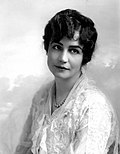The Chronophone is an apparatus patented by Léon Gaumont in 1902 to synchronise the Cinématographe (Chrono-Bioscope) with a disc Phonograph (Cyclophone)...
4 KB (320 words) - 22:03, 22 April 2024
with the movie projector, while more recent systems use timecode. The Chronophone (Léon Gaumont) "Filmparlants" and phonoscènes 1902–1910 (experimental)...
2 KB (192 words) - 17:10, 8 May 2023
only female filmmaker in the world. She experimented with Gaumont's Chronophone sync-sound system, and with color-tinting, interracial casting, and special...
44 KB (4,795 words) - 16:49, 27 July 2024
Emile Berliner. In 1902, Léon Gaumont demonstrated his sound-on-disc Chronophone, involving an electrical connection he had recently patented, to the...
149 KB (18,829 words) - 01:33, 20 June 2024
Gaumont had built in Flushing, New York in 1908 for the production of Chronophone sound films, a venture which proved unsuccessful for Gaumont. Solax produced...
4 KB (486 words) - 03:57, 4 October 2023
chez Maxim's (1933) Félix Mayol at IMDb Phonoscene with an Elephone chronophone (1905), Félix Mayol sings "La polka des trottins" (A. Trébitsch/ H. Christiné)...
3 KB (324 words) - 07:15, 18 August 2024
system designed to work with his sound-on-disc talking pictures: the chronophone. The Etablissements Gaumont was founded in 1906 to handle film production...
6 KB (654 words) - 01:15, 19 June 2024
Philippines. In 1910, the first picture with sound reached Manila, using the Chronophone. A British film crew also visited the Philippines, and filmed, among...
124 KB (14,561 words) - 12:14, 9 August 2024
discs were synchronised to a motion picture film, and were played on a Chronophone. Vitaphone "talking pictures" – 16-inch discs playing at 331⁄3 rpm provided...
95 KB (10,605 words) - 03:04, 16 August 2024
in 1917. The Phonoscène was a forerunner of sound film. It combined a chronophone sound recording with a chronograph film shot with actors lip-synching...
9 KB (913 words) - 06:12, 18 August 2024
1909 Cameraphone 1 1921 Case 1 1990 CDS 11 1974 Chace Surround 8 1905 Chronophone 106 1910 Chronomegaphone 1 1990 Cinema Digital Sound 5 1907 Cinematophone...
6 KB (159 words) - 05:24, 2 April 2022
conflagration". Probably, it was either a Chronophone or a Chonomegaphone (an enhanced version of the Chronophone). Both electrically-powered devices were...
127 KB (13,574 words) - 12:49, 18 August 2024
respective devices would be sold by a joint consortium called Gaumont-Messter-Chronophone-Biophon. Messter's Tonbilders sold well while he kept his technical superiority...
11 KB (1,380 words) - 19:40, 27 December 2023
hired by American Gaumont Chronophones, which produced phonoscènes, initially as a singer of songs recorded for the chronophone. Both Herbert Blaché and...
134 KB (15,116 words) - 07:12, 15 August 2024
and 1908, Gaumont also produced a number of sound-disc films known as "Chronophones". One of these – It Was A Nice Quiet Morning (1907) – has survived and...
13 KB (1,722 words) - 17:21, 25 February 2024
Cooper's motion picture career began around 1908 when he helped make Chronophone synchronized sound films for Gaumont which had established a studio in...
6 KB (612 words) - 03:33, 29 January 2024
chronic illness of her mother. Léon Gaumont applied for a patent for the Chronophone, his invention for presenting motion pictures with sound, with a projector...
59 KB (7,748 words) - 17:48, 2 November 2023














